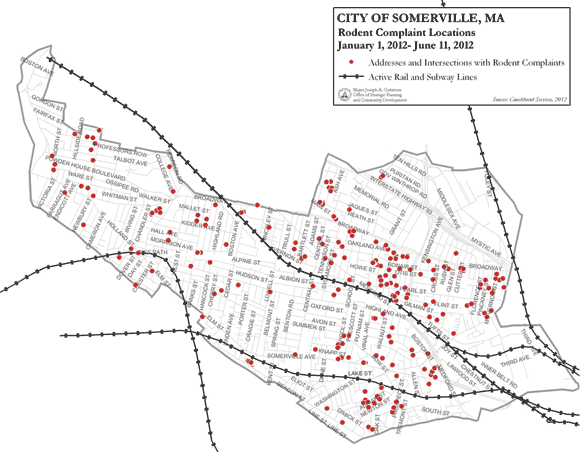Somerville tackles resident pests
*

This map shows rodent calls to city hall during the first half of the year. Click the image to download a scalable PDF version.
By Elizabeth Sheeran
Somerville generally prides itself on its diversity. But city officials have made it clear that one group of residents is not welcome here.
The local rat population has exploded this year, and the Board of Aldermen has declared war on the advancing army of rodents, enlisting the health department, city inspectors and even the city’s lawyers to formulate a battle plan.
“We’ve been asking for things to be stepped up a notch, because it’s been a real problem this summer,” said Ward Two Alderman Maryann Heuston. “There are people in the Lincoln Park area who cannot enjoy their backyards at all.”
Rats are a fact of life in any densely populated urban environment, where human animals give them lots of warm, cozy places to live, and a steady supply of food and water. But unseasonably mild winter weather this year has combined with people problems, like poor trash and property maintenance, to create an especially hospitable climate for the Norway rats who live in Somerville.
Reported rat sightings were up more than 50 percent in the first half of the year, and came from every part of the city. “We never had a good freeze this year, so they kept multiplying all winter,” said Edward Nuzzo of the Inspection Services Department, which investigates every call. “Give them food, water and shelter, and they’re not going to leave.”
That’s not just a problem because the thought of hundreds of rats scurrying around our neighborhoods gives most of us the creeps. City Health Director Paulette Renault-Caragianes said rats are great disease carriers, since they’re scavengers who travel through sewers and consume our waste. She said local rats haven’t tested positive recently for any illnesses of epidemic proportions, but that can change overnight.
“At this point in our history, it’s not the bubonic plague we’re looking at. The imminent threat at this point in time isn’t there. But they’re pests. They can be vectors for disease to happen. There’s a potential for a significant public health issue that can happen tomorrow,” she said.
Rats can also spark electrical fires by chewing through wires, destabilize buildings with their burrowing, contaminate food supplies, and generally create a “huge quality of life issue,” said Renault-Caragianes.
And controlling the rat population requires a full-out assault on all fronts, since this species can be a formidable opponent. Rats eat almost anything and can live on as little as an ounce of food a day. They reproduce in a matter of weeks. They can fit through a hole the size of a quarter, swim great distances and climb walls. They have been proven to be incredibly adaptable, even learning to avoid traps.
Renault-Caragianes said the best way to get rid of rats is to take away the welcome mat: plugging holes in walls, draining water, cutting back on vegetation, keeping food and trash in sealed containers, and keeping compost piles off the ground, with rodent-proof barriers. She said most problem spots are around residences, since the city can keep a close eye on places like restaurants, which need a license to operate. But many local homeowners may not even know they’re contributing to the problem.
“Everyone’s busy. People don’t realize that there are these kinds of things that attract rats,” said Renault-Caragianes, who said the health department is launching a campaign to proactively stop rats from spreading out, by reaching out to neighboring homes in areas around reported rodent hotspots. “Why not get rid of the stuff that’s inviting to rodents before they move in?” she said.
At the same time, Somerville has to tackle the problem of the rats who have already set up housekeeping.
Nuzzo said city inspectors respond to all rat complaints within 48 hours, and can order property owners to bring in exterminators if they see signs of rodent activity, which can be anything from a live rat to burrowing holes in the yard. They can also cite landowners for overgrown vegetation or trash violations.
But Nuzzo said inspectors can’t enter a property unless they’re invited by the owner, so they’re often limited to assessing the situation over the fence from a neighbor’s yard. And when property owners are hard to reach, or aren’t eager to cooperate, the result is a paper trail that can take weeks, long enough for a couple more litters of rats to be born. “It makes our job more difficult,” said Nuzzo.
Alderman Heuston said absentee landlords are a big issue in Ward Two, where there’s a lot of rental housing, and tenants are often new to the city and not even aware of the tough trash guidelines put in place a few years ago to combat the problem.
She said she has constituents whose homes and yards are “pristine,” but who are at the mercy of a handful of neighborhood properties that have been serving up a veritable all-you-can-eat buffet for local rats, with debris-filled yards, overgrown plants, untended fruit trees, and overflowing bird feeders.
At a recent meeting of the Aldermen’s Public Health and Safety Subcommittee, members agreed the city needs to be more aggressive with inspections and legal actions. The committee asked the city’s legal department to put together an action plan to deal with property owners who don’t cooperate, including a way to challenge the law that prohibits inspectors from going onto property without an invitation.
Heuston said that matters, because all it takes is one rat-friendly property to create a problem for the whole neighborhood. “In urban areas like Somerville where people live so close together, it’s all about the person who lives five feet away from you. If they have rats, you have rats.”















Reader Comments